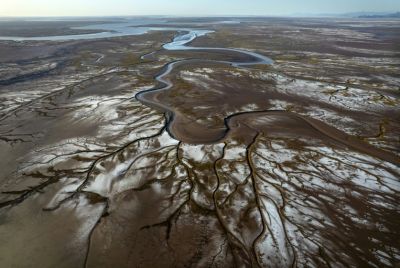Australian cities must transform for population growth
Australia circa 2050, population 35 million, climate change induced rising sea levels have flooded the Gold Coast resort region, apartment blocks are now used to grow food and people commute in monorail pods above the sea.
In another city, Australians live on floating island pods with apartments both below and above sea level, the population has shifted from land to the sea because of the sky-rocketing value of disappearing arable land.
Climate change has also forced many Australians to move inland and create new cities in the outback, relying on solar power to exist in the inhospitable interior.
These are just a few urban scenarios by some of Australia's leading architects shortlisted for Ideas for Australian Cities 2050+ to be staged at this year's Venice Architecture Biennale.
While these images may sound like science fiction, many architects and demographers say Australian cities must radically transform to cope with the pressures of population growth and climate change or face social unrest and urban decay.
If we don't get this right ... all hell breaks loose, or our cities break down, there's not enough water, there's not enough power, said one of Australia's leading demographers Bernard Salt.
Australia survived the global financial crisis, due largely to China buying its resources, and while resource exports will continue to bolster its economy for decades, future prosperity may be threatened by a growing, aging population, according to an Australian government report released in February.
The report said Australia's population was set to rise by 60 percent to 35 million by 2050, mainly through migration, yet cities are already groaning under the present population.
One of the major frontier issues for Australia over the next decade will be the future of our cities, said Heather Ridout, chief executive of the Australian Industry Group, which is calling for major infrastructure investment in cities.
Among the beneficiaries of such development would be property firms like Lend Lease, Stockland and Mirvac Group, building material groups Boral Ltd and CSR, Australia's top engineering contractor Leighton Holding Ltd, and the country's biggest private hospital operator, Ramsay Health.
But demographers warn that Australian cities need to not only expand infrastructure, but ensure future residents have equal access to city facilities.
Racial riots at Sydney's Cronulla beach in 2005 and a series of attacks against Indian students in the past year are signs of growing social tensions in Australian cities, say demographers.
If we have a rising population, we need to make sure that we have appropriate infrastructure, so that we don't lose the social cohesion that we take for granted, said Larissa Brown from the Center for Sustainable Leadership. We need affordable access to housing, to transport, to healthcare.
While Australia is double the size of Europe, three-quarters of the country is sparsely populated countryside or harsh outback, leaving the bulk of the population to inhabit a thin strip down the southeast coast. In fact, around 50 percent of the population live in the three largest cities -- Sydney, Melbourne and Brisbane -- on a combined land area that is about the size of Brunei or Trinidad & Tobago.
© Copyright Thomson Reuters 2024. All rights reserved.





















